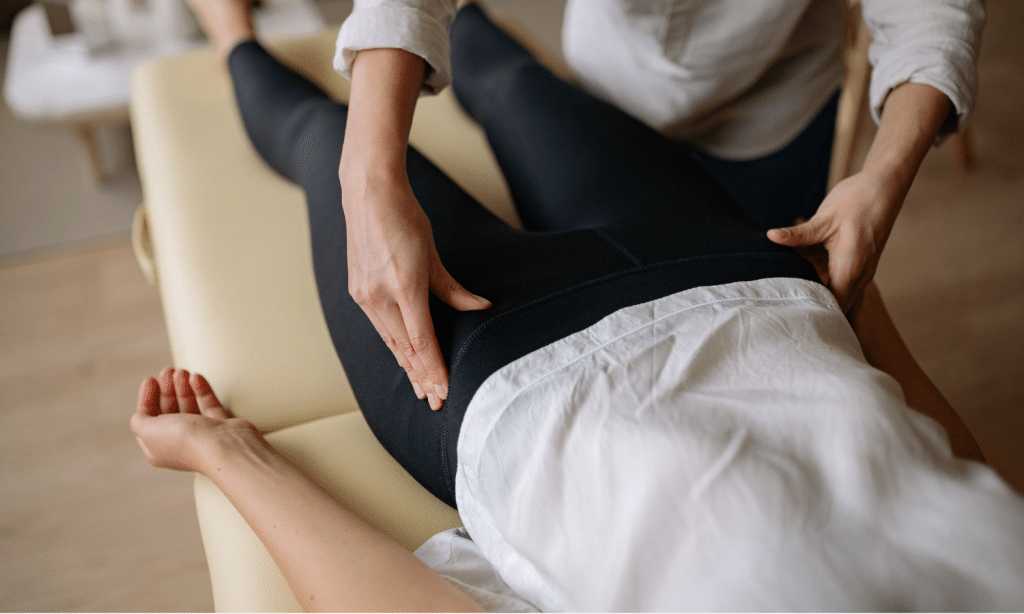
If you experience pain around the upper thigh bone (where the leg connects to the pelvis) you may have advanced osteoarthritis and not even know it.
In my practice, I typically see hip arthritis develop slowly over time and often gets couched as other issues early on like low back pain or sacroiliac dysfunction. This is because the lower back, sacroiliac joint, AND the hip can all send pain to the same place making it hard to distinguish one problem from another. Couple that with the fact that most people either have or have had lower back problems at some point, and you can easily end up overlooking hip arthritis.

Someone affected by hip degeneration is often highly functioning in the early stages. In fact, activity usually feels good, and they may even be able to do some light jogging (and even horseback riding!). This may seem a little counterintuitive, but like I said earlier – the degenerative process happens slowly over time until one day it becomes glaringly obvious there is a problem.
When symptoms start to emerge, it usually takes the form of tightness in the hips. Someone may experience a lot of restriction in rotational movements, outward movements, and movements that draw the knee closer to the chest. Eventually, prolonged positioning becomes increasingly uncomfortable, and sleep may even be affected.
Ultimately, the restrictions in mobility lead to changes in gait patterns. In cases where the joint is heavily damaged, someone won’t be able to cover up a limp and it will get worse the longer that individual continues walking or standing. At this point, where the joint is constantly inflamed, mobility is heavily compromised, walking feels like dragging a cement pillar, and the pain interrupts a restful night of sleep – it could be time for a hip replacement.

How quickly it progresses to this point has a lot to do with caring for the joint early on. Identifying a hip problem quickly can set you on a path that helps preserve the joint as long as possible – building strength, mobility, and resilience while maintaining the joint integrity. This is what we do for our patients who come to us with complaints of pain around the upper thigh region.
We start off by diving deep into all the possible causes of discomfort, pain, restriction, or limping and identify what exactly is driving the issue. The best way to do this is through a thorough physical examination where we feel how the leg is moving, what looks restricted, what feels weak, and use that information to dial in on an explanation for the problems. If we sense further imaging will help, we let you know that too.
People often get a sense of relief and clarity when a proper diagnosis is formed. Once someone understands why they are having that experience of pain, stiffness, weakness or whatever it may be for that particular individual, it can be easier to get behind the treatment and start making progress.
If you are concerned about a pain around the upper thigh, groin, hip, or buttock area and want more clarity on what exactly could be causing these issues one of our doctors would be happy to shed some light on the situation for you. You can get started by requesting a FREE Discovery Visit with a doctor to discover what’s gone wrong and if specialist physical therapy can help set you on the right path. Call us today to request your free session at (504) 407-3477.
Towards the end of July, we will be having a workshop on osteoarthritis, titled “How To Build Strong, Resilient Bones, And Prevent Fractures If You Have Been Told You Have Osteoporosis Or Osteopenia Through Healthy Strengthening.”
This class is perfect for those wanting to learn more on:
- How to go about managing your diagnosis and want advice based on the latest information and evidence
- How to to maintain your independence and quality of life into your later years
- What “Soft bones” are, and worry less about suffering from a fracture
- and so much more.
You will be able to choose from either Wednesday, July 23 @10:30A or Tuesday, July 29 @4:30P
Visit our workshop link (HERE) to sign up, and claim your FREE SEAT before they all fill up. Each class has 10 seats available, and they fill up fast.

